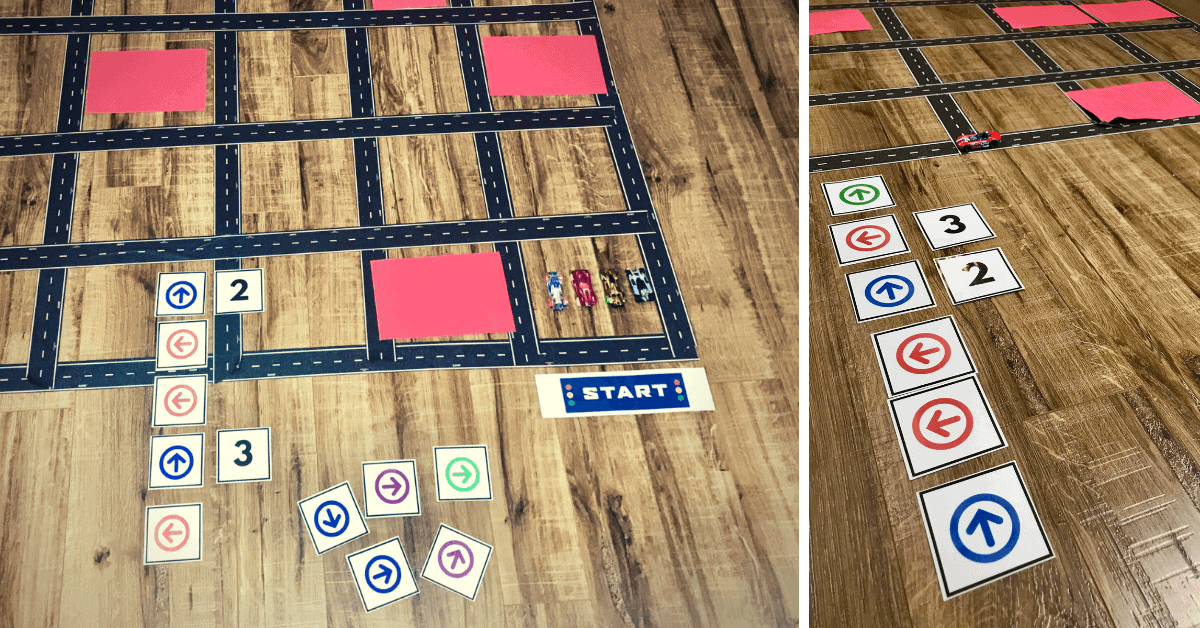Learn to Code Unplugged with Hotwheels
This post may contain affiliate links. As an Amazon Associate, I earn from qualifying purchases.
Today we have another great unplugged coding activity on the blog! When first getting started with learning to code, it’s best to start completely unplugged. Screen-free coding activities are perfect to teach coding fundamentals. Kids as young as kindergarten can learn the basic concepts of coding.
In this activity, we will be playing a grid-based coding game. Grid-based coding games are an easy way to teach kids about sequencing, algorithms and debugging. Grids are like a maze and provide kids with the challenge of giving instructions to get their ‘computer’ from start to finish.
My sons both LOVE to play with Hotwheels. In our family, Hotwheels and LEGO rule the house, and you’ll certainly find some of both in every room. In this activity, we will be learning to code by using Hotwheels cars!

What Coding Concepts Will Be Taught:
In this activity, we will be learning about the coding concepts: algorithm, sequence, and debugging.
Algorithm: An algorithm is a set of instructions given to a computer so that the computer will execute a specific task. We use algorithms every day. When we make a sandwich we follow a specific algorithm, first two slices of bread, then the filing, and then the toppings. All of the activities we do can be explained in a series of algorithms.
Sequence: A sequence is the order of tasks. When designing an algorithm, the order of tasks matters. Computers aren’t smart and need to be given instructions in a specific order or they won’t be able to properly execute the command. For example, if you are getting dressed in the morning you need to put your underwear on first before you put on your pants. If you perform these tasks in the wrong order, you may end up with your underwear on the outside of your pants!
Debugging: Debugging is a skill that all computer programmers need to establish. Debugging is a fancy way of saying fixing our mistakes. Kids who learn to code learn to be persistent and resilient. Code will inevitably have a lot of mistakes, especially when first getting started. Learning to debug and fix your mistakes teaches kids not to give up and to step up to the challenge to sort out their mistakes.

What will you need:
This activity is simple to set up and requires only about 3 minutes to set up. We used fancy car tape for our activity, but any painters tape will work just as well.
- A large open space
- A selection of Hotwheels cars
- Coding Cards (PRINTABLE)
- Painters tape or Road Tape
- Red construction paper to make ‘hot lava squares’
How to set up
Using your floor-safe painter’s tape or road tape, lay out a large square on the floor. Divide this square into a grid based on the size of your square. We made our grid 5 x 6. Feel free to adjust your measurement to your own preferred specifications.

Once you have set up your grid, cut out red squares that are the same size as your grid squares. We simply used construction paper divided in half. These will represent ‘hot lava’ and should be avoided by the Hotwheels ‘robot cars’. The more hot lava squares you create, the more challenging it will be for your programmer to make it from start to finish.

We used the start and finish signs which are available for free to print on the Hotwheels website. If you don’t want to use these, and simple signs will do.
How to Play:
This game can be played with one or two players. For two players, one player is the ‘programmer’ and one is the ‘robot car’. The programmer will give the instructions and the ‘robot car’ will follow them.
The programmer will give steps to the robot car to make it through to the finish line. Each step should be given in computer language: e.g. Move one space forward. Turn left. Move two spaces forward. The robot car will follow the commands given exactly. You can give these commands simply by talking or you can use the printable coding cards to plan the commands in advance.
For an extra challenge:
For an extra challenge, have the programmer give all the instructions in ADVANCE. Lay out the printable coding cards on the floor and have the programmer decide on all the steps needed to take the robot car from start to finish without running into an obstacle. Kids will need to have the correct sequence when they lay out their algorithm in order to successfully have their robot car land on the finish line.

Debugging:
Did the car end up at the finish line or did the car end up landing on hot lava? If the car landed on hot lava have your programmer analyze what went wrong. Coding is all about critical thinking after all. How can we fix the algorithm? This is called debugging.
Final Thoughts:
This coding game was so much fun to do! My son loved the idea of the hot lava squares. I’m not sure what makes hot lava so fun, but it’s a popular feature of every game he makes up. Having played unplugged coding games for a while now, I could see the progress my son has made in the past 6 months. Whereas previously we had to give the instructions one at a time, my son is now able to give all the instructions in advance and even debug his code. At not yet 5 years old, it’s true that even young children can grasp these early coding concepts!
Pin for Later:



Kate is mom of two rambunctious boys and a self-proclaimed super nerd. With a background in neuroscience, she is passionate about sharing her love of all things STEM with her kids. She loves to find creative ways to teach kids computer science and geek out about coding and math. She has authored several books on coding for kids which can be found at Hachette UK.








